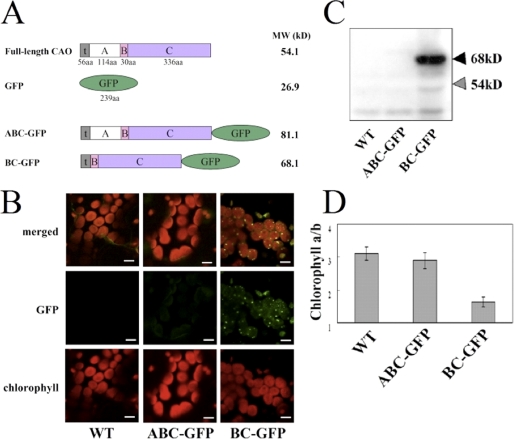FIGURE 1.
Characterization of transgenic plants expressing ABC-GFP and BC-GFP. A, schematic presentation of the domain structures of the transgenic plants expressing CAO, GFP, the full-length CAO-GFP fusion, and the BC-GFP fusion. A, B, C, t, and GFP, the A, B, and C domains of CAO, the predicted transit peptide sequence, and GFP (S65T), respectively. B, CLSM images of the wild type (WT) and transgenic plants expressing full-length (ABC)-GFP and BC-GFP fusions. Cotyledons of these plants were excited with an argon laser at 488 nm, and chlorophyll fluorescence (bottom) and GFP fluorescence (middle) were collected between 500 and 550 nm and between 600 and 680 nm, respectively. Merged images are at the top. Scale bar, 10 μm. C, immunoblot analysis of the CAO-GFP fusion protein in transgenic plants. Total protein was extracted from rosette leaves of equal fresh weight (2.5 mg) (see “Experimental Procedures”) and was subjected to SDS-PAGE. The CAO-GFP fusion or CAO proteins were detected using an anti-CAO antibody. The black arrowheads indicate the predicted molecular sizes of CAO fusion proteins (ABC-GFP, 81 kDa; BC-GFP, 68 kDa). The gray arrowheads indicate the predicted molecular size of the native CAO protein (54 kDa). All signals except that of 68 kDa were nonspecific to CAO. D, chlorophyll a to b ratios in cotyledons of the transgenic plants, n = 10–15. Note that we do not include the chlorophyll a/b ratio of ch1-1, which is the parental strain of our transgenic plants. It is because ch1-1 is unable to produce chlorophyll b, therefore, that its chlorophyll a/b ratio is infinite. Instead, we use here the Columbia WT line as a control, because this line is the background of ch1-1, and it is able to produce chlorophyll b.

